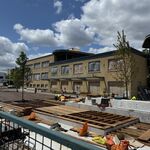I stand by my comment. The car rhetoric is hyperbole that's often counterproductive in demonizing a vast number of people who simply have few viable transport options because of the way we built things in the past.
I think as comments go,
@Towered 's was relatively muted.
He didn't target drivers per se, he targeted the way things operate day-to-day.
Car addiction vs infrastructure that disproportionately induces driving and insufficiently incents other modes may be an over simplification, but it isn't really inaccurate, nor does it vilify anyone.
The current provincial government continues to invest in the Bradford Bypass, the 413, and assorted smaller highway widenings and extensions in the GTA.
These collectively eat up more than 10B over a 10-year capital plan (the actual highways plan is ~25B over 10 years, but some can rightly be described as necessary maintenance, and other bits as necessary expansion in parts of Northern Ontario where there is not and will not be a transit alternative in the near to medium term future.)
If we simply shifted the 10B to transit, we could:
1) Install Platform Edge Doors on every Line 1 Station over 10 years
2) Deliver a 1-station extension of Line 2 to Cloverdale
3)Extend the Hurontario LRT to DT Brampton
4) Upgrade the Milton GO Line to 2WAD service - 30M frequency
5) Extend Eglinton Crosstown to Pearson
6) Build the Waterfront East LRT
7) Build the Waterfront West LRT (phase 1)
8) Extend the Sheppard Subway East to VP
****
All of that, without a parking tax or tolls, just by redirecting highway expansion money.
Now, if you also took your choice of tolls or a congestion charge, with a modest goal of raising 600M per year, or 6B over 10 years, that would buy the entire western leg of the Sheppard Subway and get you as far east as Warden too.
If you charged for parking at GO Stations, and used that money to improve service/reduce fares, you could boost service levels by 25% above pre-pandemic levels and introduce GO Co-pay in Toronto, and cut GO fares by reducing the base fare to $3.20 (from $3.70) and cut the increment pricing on GO a further 20%
****
In Toronto, charging market rates for on-street parking, including permits would easily raise another 50M per year net (very conservatively). Split that between service and fares, and you can introduce a 40-fare cap for students and seniors for monthly pricing, and still improve service on a dozen bus routes and add another 4-5 Bluenight services.
****
There's also the matter of policies, as opposed to funding; a simple choice to cap store size for food stores at 30,000ft2 or even a bit less, grandfathering existing stores, would result in more grocery stores closer to home for people, increasing walkability, and bikeability.
There's also the provincial policy on wine/beer sales, were these opened up even to every supermarket, never mind convenience stores, you would greatly reduce the number of car trips required for people's weekly needs, even if people continued to driver to pick up said supplies. (one or two less destinations)
****
In the end, perhaps 'car addiction' isn't the most useful descriptor; but neither is it wrong, nor particularly inflammatory.





